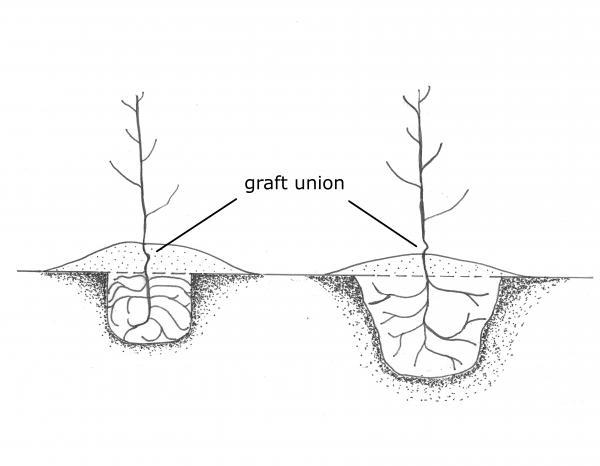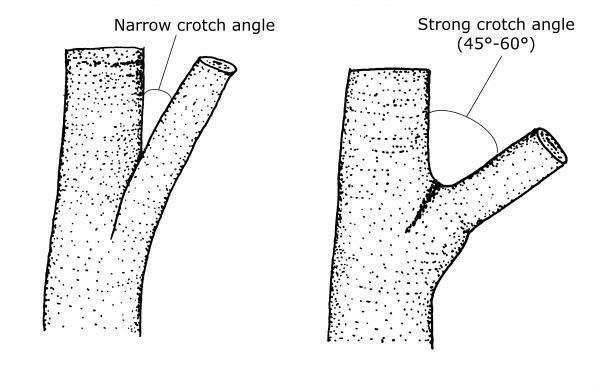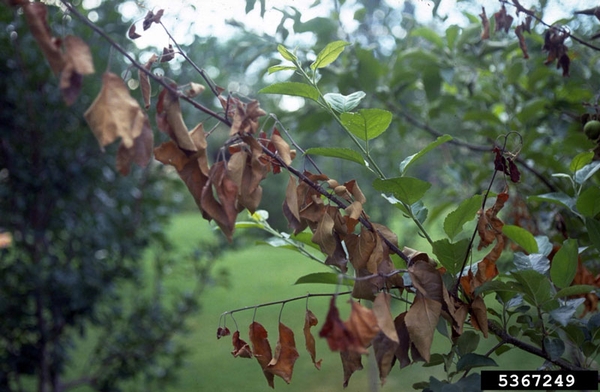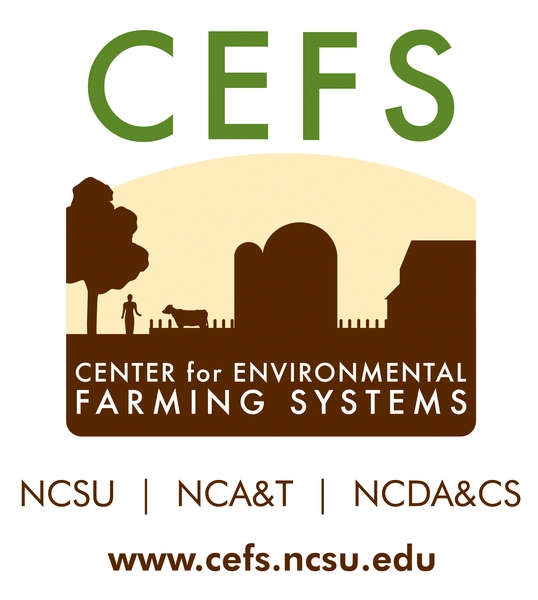Early childhood educators can easily engage children in growing, harvesting, and preparing tree fruits that provide numerous opportunities for hands-on learning. Figs, paw paws, and persimmons add year-round value to childcare outdoor learning environments by providing opportunities for children to follow seasonal changes, from flowering and leafing out to the discovery and harvest of colorful fruit to fall foliage and leaf drop. In addition, fruit trees help to increase the natural diversity of the spaces and provide pockets of shade. While growing fruit trees can be a very rewarding process, proper planning, preparation, and care of the trees take time and are essential for success.
Cultivar Selection
Selecting a fruit tree that will thrive in your location with minimal insect or disease problems reduces the maintenance required and increases the likelihood of success. For a list of recommended cultivars, see the "Tree Fruits and Nuts" chapter in the North Carolina Extension Gardener Handbook.
Maintenance Requirements:
- Low Maintenance: Figs, Paw Paws, Persimmons
- High Maintenance: Apples, Nectarines, Peaches, Pears
- Unlikely to Thrive: Apricots, Cherries, Citrus, Nectarines
For each type of tree, select two varieties that bloom at the same time to promote cross-pollination. Even self-fertile trees benefit from cross-pollination. Select trees that are known to thrive in your location using the early childhood guide from the NC State Extension Gardener Plant Toolbox.
Rootstock: Most fruit trees are grafted on to a hardy rootstock to resist pests and diseases. Rootstocks also determine the size of the tree. Dwarf rootstocks keep the tree small, make maintenance easier, and make the fruit easy to reach.
Plant
Site Selection and Preparation
The Extension Gardener Plant Toolbox provides a guide for site selection and preparation.
- Full sunlight, or at least 6 hours a day.
- Far enough away from power lines, walls, fences, and your property line to ensure that your tree will still fit when it is mature.
- Well-drained soil that prevents standing water near the roots is essential. Minimize drainage problems by planting trees in raised beds or berms 18 to 24 inches high and 4 to 5 feet wide created by shaping well-drained topsoil from the surrounding area.
- Soil amendments: For directions on how to submit a soil sample for analysis, watch this short video, How to Test Your Garden Soil, or review soil testing instructions from Extension Gardening, on how to submit a soil sample for analysis. The personalized report that you receive will provide specific recommendations for amendments including fertilizer, lime, and others.
Additional resources for managing urban soils include:
- Minimizing Risks of Soil Contaminants in Urban Gardens, NC State Extension publication AG-439-78
- Check your Dirt NC!
Timing
- Late fall or early winter.
Spacing
- Plant fruit trees 10 to 20 feet apart.
- Dig a hole that is twice as wide as the root system and as deep as the root ball. Rough up the sides of the hole with your hands or a trowel. Cut off any damaged roots or roots that are too long to fit in the hole. After you have planted the tree, fill the hole back up with native soil, and water the area well.
Mulching
- Apply organic mulch 4 to 6 inches deep under the tree stretching to the dripline (the circle formed by the tips of the outermost branches of the tree) but leave the area around the trunk free of mulch. This will improve the soil and create a good growing environment for roots.
For additional information on planting fruit trees, see the "Tree Fruits and Nuts" chapter in the North Carolina Extension Gardener Handbook.

Left: Improper planting. Soil is above the graft union, the hole is too small, and excessive roots were not trimmed. Right: Proper planting with the graft union above the soil; plenty of space for roots in the hole, and excessively long roots have been removed.
NC State, North Carolina Extension Gardener Handbook, Figure 15-18
Management
- Watering: Water the soil, not the leaves. Provide at least 1 inch of water per week during dry periods.
- Fertilizer: More is not better. Over-fertilizing can lead to poor fruit quality and excessive tree growth. Test the soil every two to four years, and watch the growth on the tree. Trees with less than 10 to 12 inches of new growth may need fertilizer. Trees with greater than 18 inches of new growth may not need fertilizer for several years. Broadcast the fertilizer on the soil surface in late winter, keeping the fertilizer at least 6 inches from the tree trunk.
- Pruning: Pruning strategies vary by the type of tree. Follow the instructions from Training and Pruning Fruit Trees in North Carolina, NC State Extension publication AG-69, for your specific tree. General pruning guidelines:
- Create a strong structural framework by selecting healthy scaffold branches that are evenly distributed around the trunk and attached at an angle between 45 and 60 degrees. Remove any sprouts attached below the graft at the base of the tree.
- Remove damaged, diseased, or dead wood.
- Remove crossing branches and those headed to the center of the tree.
- Remove branches with a narrow angle of attachment. See an example in the image below.
- Remove branches that bend downward.
- Remove branches that have excessive growth compared to other branches.
- Remove low branches that touch the ground.
- Open the canopy to light penetration and to air circulation.
- Pruning at Planting: After planting “whips” (no branches and a trunk that is ½ to ¾ inch in diameter), remove the top to leave a trunk that is only 30 to 34 inches tall.
- First Year Summer Pruning: The first summer after planting is a great time to remove undesirable growth; keep pruning to a minimum and focus on removing any shoots growing upright or any branches growing towards the ground.
- Succeeding Years: In the late winter when the tree is dormant, prune any dead, diseased, or damaged branches as well as any unwanted growth such as upright shoots. Trim any unbranched lateral branches by approximately one fourth of their length to encourage the growth of side branches. In the summer, prune any unwanted or excessive growth.
For additional information on caring for fruit trees, see the "Tree Fruits and Nuts" chapter in the North Carolina Extension Gardener Handbook.
Harvest
Harvest times vary from year to year depending on variety, cultivar, and weather. Flavor is the most reliable way to determine ripeness. When the fruit has reached its desirable size and color, pick one. If the taste is not yet desirable, test another fruit in a few days. Below are approximate harvest dates.
| Jan | Feb | Mar | Apr | May | Jun | Jul | Aug | Sep | Oct | Nov | Dec | |
|---|---|---|---|---|---|---|---|---|---|---|---|---|
| Apples | X | X | X | X | ||||||||
| Figs | X | X | X | |||||||||
| Pawpaws | X | X | X | |||||||||
| Pears | X | X | X | |||||||||
| Persimmons | X | X | X | |||||||||
| Plums | X | X | X |
Troubleshooting Common Problems
- Weather: Early and late frosts pose the greatest risks to fruit trees. Refer to the Extension Gardening page of Average First and Last Frost Dates for your location. Trees are most susceptible to late frosts in the spring when blooming and just after the petals have dropped. Unfortunately, little can be done to protect fruit tree blossoms. To determine the extent of damage after a cold snap, remove a flower shoot and place it in water to open and bloom. If the center of the opened flower is brown, the blossom is damaged and cannot bear fruit. Frost damage to new growth at the tips of branches causes little harm to the tree.
- Weed management: Weeds compete with the tree for water and nutrients. Remove all vegetation underneath trees and maintain a 3- to 4-inch layer of mulch. Avoid using hoes, weed trimmers, or tillers under the tree canopy as they could harm roots near the surface and damage the trunk. Consider placing an 18-inch-long piece of 4-inch corrugated plastic drainage pipe to encircle the base of the trunk. Make a linear cut down one side of the pipe and place it around the trunk to prevent herbicide injury, damage from lawn mowers and weed eaters, and animals.
- Fire blight: A bacterial disease spread by bees during bloom, fire blight affects fruit trees such as apples and pears, and appears in late spring to summer. When a tree is infected, new shoots rapidly turn black and die; newly infected wood has pink-orange streaks. Fire blight is most easily spread when temperatures are between 75°F and 85°F with high humidity or precipitation. Prune out the infected branches by cutting 10 to 12 inches below the infected area. Sanitize all tools with a 10 percent bleach solution or concentrated Lysol disinfectant (which will not discolor fabric) after each cut to prevent spreading.
For additional information on troubleshooting common tree fruit problems, see "Appendix C. Diagnostic Tables" in the North Carolina Extension Gardener Handbook.
Fun With Fruit Trees
Books
- What Grows on Trees? by Liza Charlesworth
Videos
- "The Seasons of Arnold's Apple Tree Read Aloud." Mrs. Clark's Reading Corner. October 4, 2017. Video.
- "The Apple Pie Tree Read Aloud by Zoe Hall." Mr. Inquiry. September 6, 2022. Video.
Activities
Additional Resources
- North Carolina Extension Gardener Handbook
- The Natural Learning Initiative
- Comprehensive Resources for Fruit Trees
- Garden Help Directory — Contact the local N.C. Cooperative Extension center in your county.
Acknowledgments
Funding for this publication was provided in part by the John Rex Endowment.
The authors would like to thank Melissa Bell, Research Associate, Center for Environmental Farming Systems Field Research, Education and Outreach Liaison, NC State University, for their management of the review process.
This publication was developed in partnership with the Natural Learning Initiative in the College of Design at North Carolina State University.
About the Local Foods Series: Childcare Center Production Gardens
This publication in the Local Foods series is one of 15 publications about childcare center production gardens:
- Growing and Cooking Fruits and Vegetables at Childcare Centers (LF-007-01)
- Creating Childcare Center Production Gardens (LF-007-02)
- Growing Warm-Season Fruits and Vegetables in Childcare Production Gardens (LF-007-03)
- Growing Cool-Season Vegetables in Childcare Production Gardens (LF-007-04)
- Snacking and Cooking with Warm-Season Produce from Childcare Production Gardens (LF-007-05)
- Snacking and Cooking with Cool-Season Produce from Childcare Production Gardens (LF-007-06)
- Composting in Childcare Center Production Gardens (LF-007-07)
- Vermicomposting in the Childcare Center Production Gardens (LF-007-08)
- Introducing Children to Insects in Childcare Center Gardens (LF-007-09)
- Easy Fruits to Grow at Childcare Center Gardens (LF-007-10)
- Growing Strawberries in Childcare Center Gardens (LF-007-11)
- Managing Weeds in Childcare Center Gardens (LF-007-12)
- Growing Fruit Trees in Childcare Center Gardens (LF-007-13)
- Growing Muscadines in Childcare Center Gardens (LF-007-14)
- Growing Blueberries in Childcare Center Gardens (LF-007-15)
Publication date: July 27, 2023
LF-007-13
N.C. Cooperative Extension prohibits discrimination and harassment regardless of age, color, disability, family and marital status, gender identity, national origin, political beliefs, race, religion, sex (including pregnancy), sexual orientation and veteran status.





